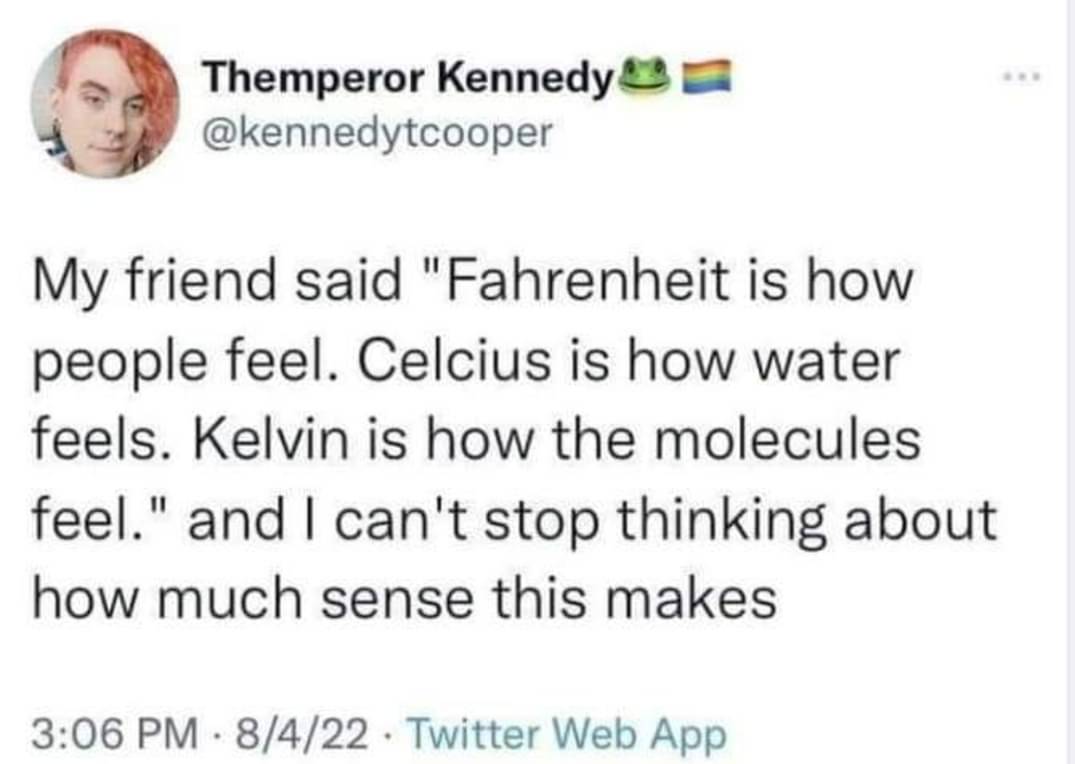this post was submitted on 12 Mar 2024
596 points (76.5% liked)
Science Memes
11021 readers
3635 users here now
Welcome to c/science_memes @ Mander.xyz!
A place for majestic STEMLORD peacocking, as well as memes about the realities of working in a lab.

Rules
- Don't throw mud. Behave like an intellectual and remember the human.
- Keep it rooted (on topic).
- No spam.
- Infographics welcome, get schooled.
This is a science community. We use the Dawkins definition of meme.
Research Committee
Other Mander Communities
Science and Research
Biology and Life Sciences
- !abiogenesis@mander.xyz
- !animal-behavior@mander.xyz
- !anthropology@mander.xyz
- !arachnology@mander.xyz
- !balconygardening@slrpnk.net
- !biodiversity@mander.xyz
- !biology@mander.xyz
- !biophysics@mander.xyz
- !botany@mander.xyz
- !ecology@mander.xyz
- !entomology@mander.xyz
- !fermentation@mander.xyz
- !herpetology@mander.xyz
- !houseplants@mander.xyz
- !medicine@mander.xyz
- !microscopy@mander.xyz
- !mycology@mander.xyz
- !nudibranchs@mander.xyz
- !nutrition@mander.xyz
- !palaeoecology@mander.xyz
- !palaeontology@mander.xyz
- !photosynthesis@mander.xyz
- !plantid@mander.xyz
- !plants@mander.xyz
- !reptiles and amphibians@mander.xyz
Physical Sciences
- !astronomy@mander.xyz
- !chemistry@mander.xyz
- !earthscience@mander.xyz
- !geography@mander.xyz
- !geospatial@mander.xyz
- !nuclear@mander.xyz
- !physics@mander.xyz
- !quantum-computing@mander.xyz
- !spectroscopy@mander.xyz
Humanities and Social Sciences
Practical and Applied Sciences
- !exercise-and sports-science@mander.xyz
- !gardening@mander.xyz
- !self sufficiency@mander.xyz
- !soilscience@slrpnk.net
- !terrariums@mander.xyz
- !timelapse@mander.xyz
Memes
Miscellaneous
founded 2 years ago
MODERATORS
you are viewing a single comment's thread
view the rest of the comments
view the rest of the comments

I can absolutely tell 65°C is too hot, that's 5°C short of what is piped as literal hot water in the taps in my area.
I would not recommend going above 40°C for washing, and there is literally zero issue remembering that. Body temperature of a healthy human is 36,6-36,7°C (97,9-98,1°F), everything above that is hot.
As such, there is literally zero issue figuring 40°C is reasonably hot and 65°C is unreasonably hot, it doesn't take a genius.
Speaking of water, Celsius is obviously superior as a water-based system. I can easily tell temperature in my kettle goes to 100°C (212°F, huh?), or steps down to 90°C (194°F??) or 80°C (176°F??) to brew a perfect cup of tea. When temperature outside goes 0°C (32°F??), I know I can expect ice and snow. And for everything in between, I can make a pretty accurate approximation.
And finally, modern Fahrenheit scale is literally defined through Celsius. It's a scale that is defined as 32°F at the freezing point of water (i.e. 0°C) and 212°F at water boiling point (i.e. 100°C). You're literally using Celsius but make it harder for no reason.